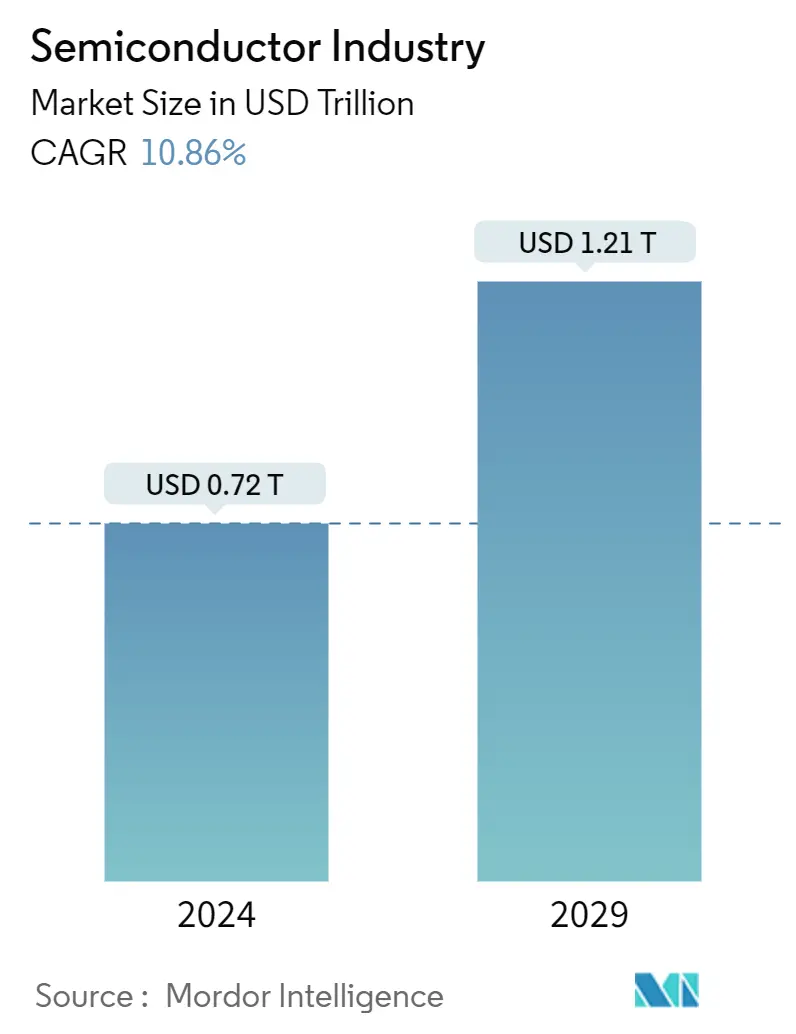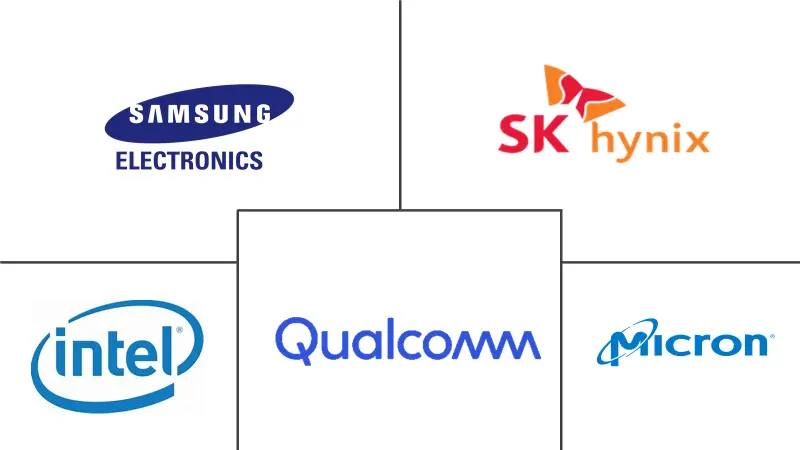Market Size of Semiconductor Industry

| Study Period | 2021-2029 |
| Market Size (2024) | USD 0.72 Trillion |
| Market Size (2029) | USD 1.21 Trillion |
| CAGR (2024 - 2029) | 10.86 % |
| Fastest Growing Market | Asia Pacific |
| Largest Market | Asia Pacific |
Major Players*Disclaimer: Major Players sorted in no particular order |
Semiconductor Market Analysis
The Semiconductor Industry is expected to grow from USD 0.72 trillion in 2024 to USD 1.21 trillion by 2029, at a CAGR of 10.86% during the forecast period (2024-2029).
- The semiconductor sector is experiencing a swift expansion as semiconductors are becoming the fundamental components of contemporary technology. The progress and breakthroughs in this industry are directly influencing all subsequent technologies.
- Semiconductor devices are electronic components that use semiconducting material as their foundation. This material produces transistors, diodes, and other fundamental functional units found in integrated circuits (ICs). These devices are characterized by their ability to neither conduct electricity well nor act as effective insulators. The benefits of semiconductor devices encompass their affordability, dependability, and compact size. Over the past few decades, the utilization of these devices in the production of diverse electronics has surged in popularity, and it is projected to continue gaining momentum in the forthcoming years.
- The semiconductor industry is projected to experience strong growth in the foreseeable future as it caters to the rising need for semiconductor materials in emerging technologies like artificial intelligence (AI), autonomous driving, the Internet of Things, and 5G. This growth is fueled by intense competition among key players and consistent investment in research and development (R&D). As a result, vendors are constantly driven to innovate and gain a competitive advantage in the market.
- The market demand for semiconductor devices is projected to rise due to businesses' widespread adoption of electrification and autonomy. Electric vehicles are spearheading the movement toward a sustainable future, with electronics and semiconductors serving as crucial components. Governments across the globe are setting ambitious goals for the electrification of their transportation sectors, prompting leading automakers to make substantial investments in electric vehicle research and development. Semiconductors are emerging as the central processing units of EVs, empowering them to deliver optimal performance. Consequently, the growing investments in electric vehicles are anticipated to fuel the demand for the semiconductor market.
- The semiconductor industry needs more skilled workers. By the year 2030, more than one million additional skilled workers are likely to be needed to meet the industry's demand. Further, the semiconductor industry is characterized by long lead times and high capital investments. Manufacturing capacity constraints and changes in demand have led to shortages in the supply chain. These factors are expected to challenge the market's growth.
- The sector has undergone substantial changes due to COVID-19, impacting customer behavior, business revenues, and corporate operations. Additionally, the pandemic has revealed previously unnoticed risks on the supply side, potentially resulting in shortages of essential parts and components. Consequently, semiconductor companies are proactively restructuring their supply chains to enhance resilience, and these adjustments may persist in the post-pandemic era.
Semiconductor Industry Segmentation
Semiconductors are essential technology enablers that power many of the cutting-edge digital devices. The global semiconductor industry is set to continue its robust growth well into the next decade due to advancements in emerging technologies, such as autonomous driving, artificial intelligence (AI), 5G, and Internet of Things (IoT), coupled with consistent spending on R&D and competition among the prominent players.
The semiconductor industry landscape into semiconductor devices (discrete semiconductors, optoelectronics, sensors, and integrated circuits), semiconductor equipment (front-end equipment and back-end equipment), semiconductors materials (fabrication and packaging), semiconductor foundry market, outsourced semiconductor assembly test services (OSAT) market.
The market sizes and forecasts are provided in terms of value (USD) for all the above segments.
| By Semiconductor Devices | |
| Discrete Semiconductors | |
| Optoelectronics | |
| Sensors | |
| Integrated Circuits |
| By Semiconductor Equipment | |
| Front-end Equipment | |
| Back-end Equipment |
| By Semiconductors Materials | |
| Fabrication | |
| Pacakging |
Semiconductor Industry Size Summary
The semiconductor industry is undergoing rapid expansion, driven by its integral role in modern technology. Semiconductors, which are essential components in electronic devices, are experiencing increased demand due to their affordability, reliability, and compact size. This growth is further propelled by advancements in artificial intelligence, autonomous driving, the Internet of Things, and 5G technologies. The industry's expansion is also fueled by the electrification and autonomy trends in various sectors, particularly in electric vehicles, where semiconductors are crucial for optimal performance. However, the industry faces challenges such as a shortage of skilled workers, long lead times, and high capital investments, which can impact supply chain stability and market growth.
The market for semiconductor fabrication materials is expanding, supported by the rising use of digitally integrated ICs across industries like automotive, telecommunications, and energy. Silicon and gallium arsenide are the most commonly used materials in semiconductor fabrication, each with distinct advantages and limitations. The industry is also exploring new materials with promising properties, which could revolutionize semiconductor fabrication. Major players like Intel, Samsung, Qualcomm, Micron, and SK Hynix are actively engaging in partnerships and acquisitions to enhance their product offerings and maintain competitive advantages. Recent technological advancements, such as Micron's introduction of the 16Gb DDR5 memory and Intel's collaboration with Tower Semiconductor, highlight the industry's commitment to innovation and growth.
Semiconductor Industry Market Size - Table of Contents
-
1. MARKET INSIGHTS
-
1.1 Market Overview
-
1.2 Technological Trends
-
1.3 Industry Value Chain/Supply Chain Analysis
-
1.4 Impact of COVID-19, Macro Economic Trends, and Geopolitical Scenarios
-
1.5 Industry Attractiveness - Porter's Five Forces Analysis
-
1.5.1 Bargaining Power of Suppliers
-
1.5.2 Bargaining Power of Buyers
-
1.5.3 Threat of New Entrants
-
1.5.4 Threat of Substitutes
-
1.5.5 Intensity of Competitive Rivalry
-
-
-
2. MARKET SEGMENTATION
-
2.1 By Semiconductor Devices
-
2.1.1 Discrete Semiconductors
-
2.1.2 Optoelectronics
-
2.1.3 Sensors
-
2.1.4 Integrated Circuits
-
-
2.2 By Semiconductor Equipment
-
2.2.1 Front-end Equipment
-
2.2.2 Back-end Equipment
-
-
2.3 By Semiconductors Materials
-
2.3.1 Fabrication
-
2.3.2 Pacakging
-
-
2.4 By Semiconductor Foundry Market
-
2.5 By Outsourced Semiconductor Assembly Test Services (OSAT) Market
-
Semiconductor Industry Market Size FAQs
How big is the Semiconductor Industry?
The Semiconductor Industry size is expected to reach USD 0.72 trillion in 2024 and grow at a CAGR of 10.86% to reach USD 1.21 trillion by 2029.
What is the current Semiconductor Industry size?
In 2024, the Semiconductor Industry size is expected to reach USD 0.72 trillion.


